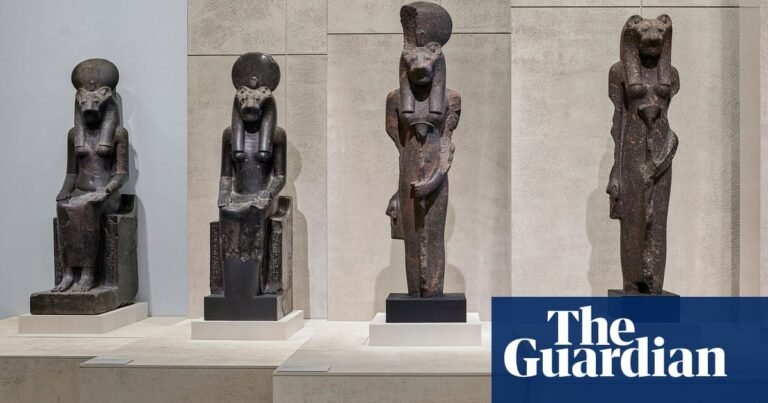If you walk past the gigantic head of Nectanebo I (who is perhaps actually Nectanebo II, we don’t know), and the 5,000-year-old hippopotamus ivory “sandal label” (like an Ancient Egyptian Croc jibbitz, as one National Gallery of Victoria employee puts it), you will come across a remarkably benevolent-looking lion.
The red granite statue, lounging handsomely in the NGV’s new show, Pharaoh, is not that special at first glance, apart from the craftmanship required to make a hunk of rock look like it has just finished a rather good meal. But this lion gives us a fascinating glimpse into the humanity of Ancient Egypt’s rulers – real people who once lived and breathed, who are now hidden away beneath the inscrutable carvings we marvel over in museums around the world.
The lion is one of a pair made sometime around 1390 to 1352BCE, to guard a temple erected by the Pharaoh Amenhotep III. He had a particularly prosperous reign; to this day, he is thought to be the richest person to have ever lived. But decades later, Amenhotep III’s grandson Tutankhamun ordered that the lions be reinscribed, to add his own name. Why? It is thought to have been a futile attempt to link his reign to his grandfather, instead of his controversial father Akhenaten, who had been scandalously monotheistic and was widely regarded as a heretic for it.
But the rewriting of history via scribbling on lions didn’t end there. One thousand years later, the Kushite king Amanislo had his name added and moved the lions to the kingdom of Kush in modern-day Sudan. There they remained until the 19th century, when British explorer Lord Prudhoe got his mitts on them – and of course, added his name to them too. (Not literally, but the Britons redubbed the statues “the Prudhoe Lions”).
This one statue, among 500 objects in this enormous exhibition from the British Museum, encapsulates so much about what fascinates us about the Pharaohs. The mad power struggles, the obsession with legacy, the ruthless self-promotion, the subsequent plunder of their treasures. Even the daddy issues: all are reminders that people who lived that long ago, even the Pharaohs, weren’t all that different to us.
“It is a very human motivation, to try get out of his father’s shadow,” says Dr Marie Vandenbeusch, British Museum’s international touring exhibitions curator, of Tutankhamun’s attempt to rewrite history. “But he was still the son of Akhaneten, so afterwards they started removing his name and reused a lot of statues.
“So we can see that this lion meant something to Amenhotep III, to Tutankhamun and to everyone else who came after – all these statues had a sort of life, they are not set in stone. But it’s still meaningful to us because it is about power, control and showing off, which are all motivations we can understand.”
Pharaoh is the biggest international show the British Museum has ever staged in its 270-year-history, and the biggest Ancient Egyptian show ever staged in Australia. Given the prevailing wisdom among Australian museums is that dinosaurs and mummies are what gets bums off seats, that’s saying something.
But Pharaoh, arriving in Australia so soon after the Ramses exhibition in Sydney, feels startlingly unique. For one, there are no human remains, an increasingly contentious part of Egyptology. And secondly, for how it looks. The exhibition is the result of eight years of discussion between the British Museum and the NGV, and all the work shows. It is beautifully laid out, though I admit to flinching when I entered the first room, which is starkly clinical – more reminiscent of Paul Atreides’ house than the usual Egyptian exhibition. But by the time I reached the lion, in a room laid out like a temple, complete with obelisk pylons at the door, I found it all almost overwhelmingly grand.
“You get used to Egyptian exhibitions being very dark and I like that this is super light,” says Vandenbeusch, who proposed that the exhibition would be lit as if by sun, bright at the beginning and dark by the end. “It’s great to actually be able to see the artefacts.”
And there are some remarkable sights to be seen. A colossal clenched fist, once attached to an enormous status of Ramses II, that was lifted from Egypt by none other than Napoleon himself during his campaign in 1798.
A few examples of Amenhotep III’s 720 statues the lion-headed goddess Sekhmet, having decided the best way to appease her was to commission 365 statues of her standing and 365 of her sitting. (And for just one temple.)
There are even a few fragments of quotidian life found in the village of Deir el-Medina, where craftspeople lived while building the Valley of the Kings. These objects include texts where someone complains about having to go to work, and a very charming shard of pottery depicting baboons gorging on figs. (“I think it is really fantastic,” Vandenbeusch says, gazing on it fondly).
About 300 Pharaohs ruled Ancient Egypt over 3,000 years. They were not always men, or even always Egyptian: take Alexander the Great, who is included twice in the NGV exhibition – as a small bust in the naturalistic Greek style, and also carved into sandstone in the Egyptian style, shown making an offering to a bull.
But some things never change. Take that 5,000-year-old sandal label – the oldest object in the whole exhibition – which depicts King Den smiting an unfortunate captive. “What I find fascinating about it is that the king wanted this in 3,000BC, but then you see that same imagery throughout the pharaonic history,” Vandenbeusch says. “They really wanted to be seen smiting people.”
It is important to know that the mask-like faces on statues and carvings are not intended to be portraits, she adds: “They are highly curated. They decided how they wanted to look like.”
And from the style of their crown down to the size of their ears, every detail tell reveals a lot about the person, not the Pharaoh.
“Amenhotep III always looks older, a bit sad and with big ears. That’s exactly what he wanted – older and sadder meaning wiser, and the ears mean he is listening,” Vandenbeusch says. “You have to decode everything, but that is the fascinating thing with Ancient Egypt: everything can be decoded.”

